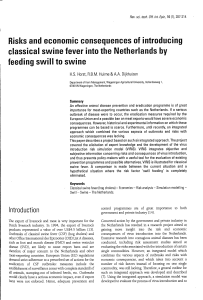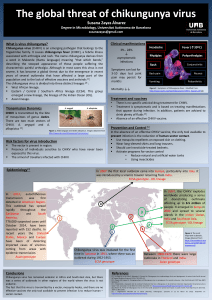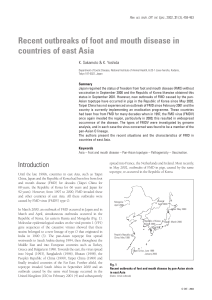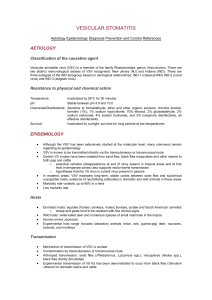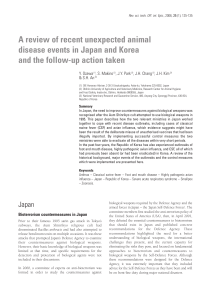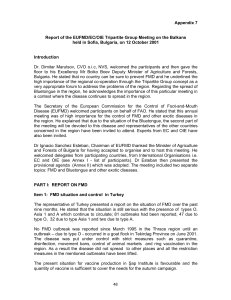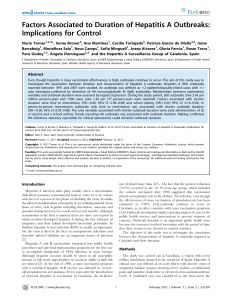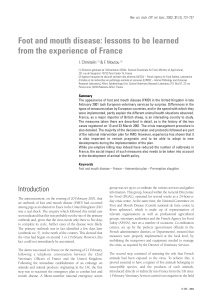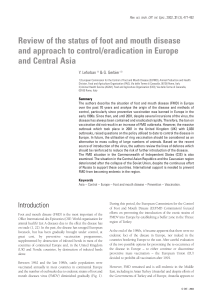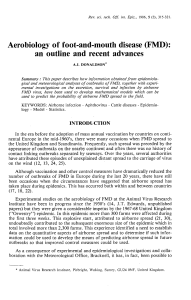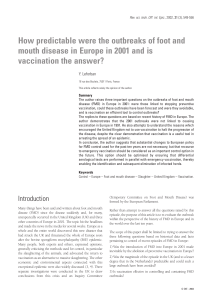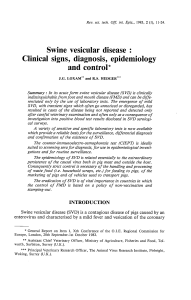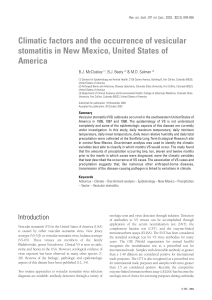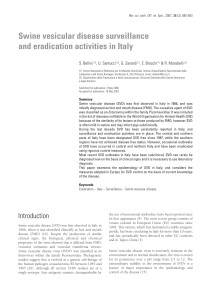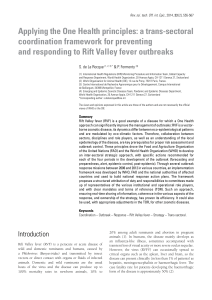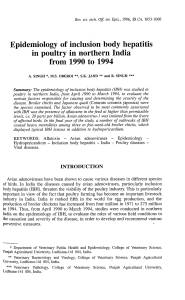D8573.PDF
publicité
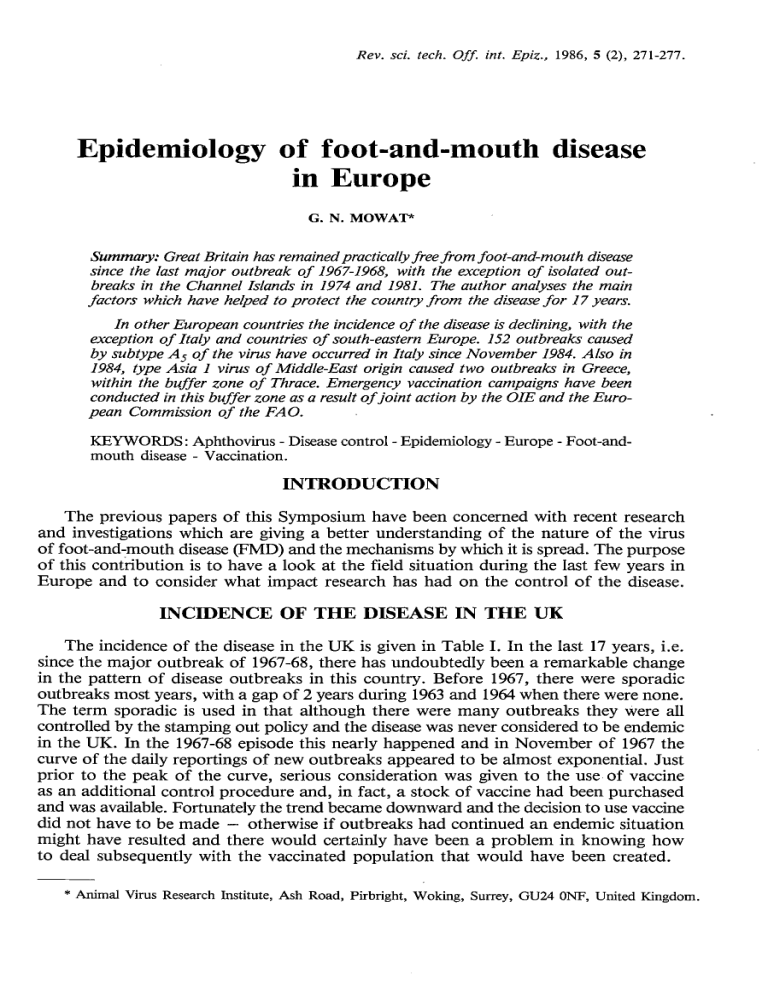
Rev. sci. tech. Off. int. Epiz., 1986, 5 (2), 271-277. Epidemiology of foot-and-mouth disease in Europe G. N. MOWAT* Summary: Great Britain has remained practically free from foot-and-mouth disease since the last major outbreak of 1967-1968, with the exception of isolated out­ breaks in the Channel Islands in 1974 and 1981. The author analyses the main factors which have helped to protect the country from the disease for 17 years. In other European countries the incidence of the disease is declining, with the exception of Italy and countries of south-eastern Europe. 152 outbreaks caused by subtype A5 of the virus have occurred in Italy since November 1984. Also in 1984, type Asia 1 virus of Middle-East origin caused two outbreaks in Greece, within the buffer zone of Thrace. Emergency vaccination campaigns have been conducted in this buffer zone as a result of joint action by the OIE and the Euro­ pean Commission of the FAO. KEYWORDS: Aphthovirus - Disease control - Epidemiology - Europe - Foot-andmouth disease - Vaccination. INTRODUCTION The previous papers of this Symposium have been concerned with recent research and investigations which are giving a better understanding of the nature of the virus of foot-and-mouth disease (FMD) and the mechanisms by which it is spread. The purpose of this contribution is to have a look at the field situation during the last few years in Europe and to consider what impact research has had on the control of the disease. INCIDENCE OF T H E DISEASE IN T H E UK The incidence of the disease in the U K is given in Table I. In the last 17 years, i.e. since the major outbreak of 1967-68, there has undoubtedly been a remarkable change in the pattern of disease outbreaks in this country. Before 1967, there were sporadic outbreaks most years, with a gap of 2 years during 1963 and 1964 when there were none. The term sporadic is used in that although there were many outbreaks they were all controlled by the stamping out policy and the disease was never considered to be endemic in the UK. In the 1967-68 episode this nearly happened and in November of 1967 the curve of the daily reportings of new outbreaks appeared to be almost exponential. Just prior to the peak of the curve, serious consideration was given to the use of vaccine as an additional control procedure and, in fact, a stock of vaccine had been purchased and was available. Fortunately the trend became downward and the decision to use vaccine did not have to be made — otherwise if outbreaks had continued an endemic situation might have resulted and there would certainly have been a problem in knowing how to deal subsequently with the vaccinated population that would have been created. * Animal Virus Research Institute, Ash Road, Pirbright, Woking, Surrey, GU24 ONF, United Kingdom. — 272 — TABLE I The number 1957 1958 1959 1960 1961 1962 1963 1964 1965 1966 1967 1968 1969 1970 1971 of outbreaks 184 116 45 298 103 5 - -1 34 2,210 187 — - - of FMD in the United Kingdom, 1972 1973 1974 1975 1976 1977 1978 1979 1980 1981 1982 1983 1984 1985 1957-1985 1 [Jersey] -— - — -— 2 [Jersey & Isle of Wight] — - Since J u n e of 1968 until the present time, i.e. some 17 years, there have only been two further episodes and neither of these was o n the mainland of the U K . In 1974 there was one outbreak at St. Peter's P o r t o n Jersey, in the Channel Islands, and in 1981 there was another outbreak o n Jersey and one outbreak on the Isle of Wight. The 1974 outbreak was due to type C virus and this coincided with the much bigger number of outbreaks (89) due to the same virus serotype in Brittany. Again in 1981, the type O outbreaks in Jersey and the Isle of Wight coincided with the large epizootic in pigs in N o r m a n d y . Earlier papers in this Symposium described how research into the rates of virus excretion, airborne survival and analysis of weather conditions made it possible t o predict what the outcome of these French outbreaks was likely to b e . Also the newer biochemical methods of comparing virus strains showed the great similarity, if not identical characteristics, of the viruses in the coinciding outbreaks. A p a r t from these two episodes, however, the 17 year period from mid-1968 until the present time has shown a very different pattern compared with the 10 years before. There has obviously been a very significant change. If epidemiology is about the incidence, the mechanisms of spread a n d understanding the life cycle of the infective agent, then control is very much concerned with how to break into that life cycle and so prevent propagation of the organism and continuance of the disease. In the U K several factors have contributed to this becoming possible. FACTORS CONTRIBUTING TO T H E CONTROL OF F M D IN T H E UK Some of the most important factors are given in Table II. One of the most signifi­ cant, which has contributed to the control of the disease, has come from the recom­ mendations of the Northumberland Committee - i.e. the UK no longer imports whole carcass meat, and only boned a n d / o r jointed meat from which the lymph glands have been removed is brought into the country. There is no doubt that on m a n y occasions in the past, carcasses of cattle in the p r o d r o m a l stages of the disease, with virus sur­ viving in bone m a r r o w and lymphatic tissue, must have been introduced. In stopping — 273 — T A B L E II Factors contributing to the control of FMD disease in the UK 1. Recommendations of the Northumberland Committee of Enquiry on Foot-and-Mouth Disease. 2. Diseases of Animals [waste food] Order, 1973. 3. Much reduced incidence of FMD on the continent of Europe. the importation of whole carcasses, one is reducing the opportunity for introduction and also the a m o u n t of virus available t o initiate primary outbreaks. Allowing the virus entry is one factor, presenting it t o the susceptible population is another. O n e route which must have caused m a n y outbreaks in the past was the use of swill or garbage for the feeding of pigs. Waste food, including offal, bones, etc. containing virus fed t o pigs without proper heat treatment must have caused m a n y o u t b r e a k s . The 1972 outbreak of swine vesicular disease (SVD) highlighted the very unsatisfac­ tory state of affairs in relation to swill feeding of pigs in the U K . Control via the 1957 legislation was not effective. Local Authorities were not able to supervise premises adequately a n d there were loopholes in the law; e.g. farmers with only one or two pigs were not required t o be licensed. The 1973 legislation put control in the h a n d s of the Ministry of Agriculture, Fisheries and Food and was much tougher - i.e. there h a d to be pre-treatment areas for food collection and processing and also a clean area for treated swill. T h e design of the premises h a d to be such that pigs could not have access t o the pre-treated food. The efficiency of the plant h a d to be adequate, i.e. it really did boil the food and n o t just w a r m it as in so m a n y of the older establishments. These new requirements had a very beneficial effect in that m a n y of the poorer establishments could not meet the new conditions and went out of business. T h e number of swill feeding premises reduced from over 4,000 t o under 1,100. The effect of these new regulations has been that not only are the benefits related to SVD, b u t also any other disease associated with transmission by feeding, such as F M D . Small a m o u n t s of virus in lymphatic tissues that are brought into the country are prevented from making contact with susceptible pigs as a result of the tightening u p of the conditions for feeding swill. T h e third factor contributing to the improved situation is the m u c h reduced in­ cidence of the disease on the continent of E u r o p e . In the past, m a n y of the outbreaks in the UK m a y have resulted from virus from outbreaks in countries bordering the Channel reaching cattle in this country. One of the early popular theories on transmission was that birds brought the virus on their feathers and feet. However, in view of the work done o n aerosol transmis­ sion over the sea, it would be plausible to think t h a t these coastal outbreaks resulted from windborne transmission. There were m a n y such outbreaks in the U K during November 1951 to April 1952. In France alone in 1952 there were 320,000 outbreaks and there were also very large numbers in the Netherlands. The conditions existed, therefore, relatively close by, to p r o m o t e the transmission of virus t o the UK. Subsequently it was a result of combined policies of veterinary zoo-sanitary measures and mass vaccination that the downward trend in outbreaks was achieved and in many respects Europe can be regard­ ed as one of the real success stories in bringing F M D under control. Table III shows that our nearest neighbours across the Channel are continuing, by and large, to main­ tain that control. — 274 — TABLE III Numbers 1957 1958 1959 1960 1961 1962 1963 1964 1965 1966 1967 1968 1969 1970 1971 1972 1973 1974 1975 1976 1977 1978 1979 1980 1981 1982 1983 1984 1985 of outbreaks of FMD in 3 European countries close to the UK France Belgium Netherlands 99,424 14,127 6,188 7,382 2,626 199 28 56 10 59 17 40 35 4 8 2 1 89 2 328 588 57 180 121 6 67 2 112 323 22 1 3 2 1 40 11 6 3 179 5,470 2,103 146 1,426 2,194 196 - 1 21 - -- - 21 7 - - 60 21 1 3 2 - 1 - - -- — - 18 - - ' - - - - - - 4 2 - THE EUROPEAN SITUATION With respect to other parts of E u r o p e where the situation is not as favourable, Table IV shows the F M D position in 1983-1985. It can be seen that several countries had small numbers of outbreaks. Of particular importance were the two outbreaks of Asia 1 in Greece, a serotype exotic t o E u r o p e . Also it is worth noting that two near neighbours, namely Turkey and the USSR, reported outbreaks due to A , a variant of serotype A which is also exotic t o E u r o p e . 2 2 F M D IN ITALY A t present the main interest in E u r o p e is centred on the epizootic in Italy. Startting in M o d e n a in November of last year, there haVe been 152 outbreaks so far. The origin of the outbreak is still obscure; however, it may be of some significance that M o d e n a is an i m p o r t a n t trading centre for young cattle brought into Italy from — 275 FMD position I ABI I I V in Europe (number of outbreaks in 1983, 1984 and 1985 1984 1983 Denmark Netherlands Spain Portugal Jan. 1 - O, Dec. 4 - O, Jan./July 9 - A Jan./June 133 - A - — 5 5 Germany, F.R. and virus Greece Italy - Turkey USSR 465 - A , O Jan. /June 6 — 0 ¡ Nov./Dec. 8 - A^ Jan./Feb. 2 - O, Jan./Apr./June 22 - A June 2 — A Oct. 1 - O, June 2 — Asia 1 Nov./Dec. 45 - A 438 - A , O Apr./Sept. 6 —A 1985 - 5 5 5 22 types) 22 Jan./April 69 - A 5 22 P. Stouraitis - 1985. Germany. Italy imports between 1 a n d 2 million young beef animals for fattening each year. A major trading route starts at Rosenheim in West G e r m a n y . Cattle are collected from many parts of Europe and taken south through Austria to Modena. F r o m M o d e n a , calves are sold to farms all over Italy. Infection m a y have been introduced with imported calves. Relatively uncontrolled movement of livestock t h r o u g h o u t the country has resulted in the disease becoming widespread. It has also been found that vaccination campaigns have not been as complete or as effective as was previously t h o u g h t . The A V R I has been collaborating with the Brescia Institute on characterisation of the strain responsible. The virus is clearly of the A subgroup and indistinguishable from the strain isolated in 1962 at P a r m a and developed into a vaccine strain. 5 T h e virus genetics group at Pirbright have been examining a n u m b e r of isolates collected sequentially from outbreaks with the aim of following evolutionary changes in the strain under these field conditions. They have examined 25 isolates collected during November 1984 to mid-February of this year. Three isolates from early December, late December and mid-January are indistinguishable from the P a r m a vaccine strain. The m e t h o d used is analysis of the coat proteins by iso-electric focusing. Of the other 22 isolates, 4 0 % are altered in one polypeptide, 4 4 % in two polypeptides and 4 % in 3 polypeptides. It is of interest, however, t h a t the V P 1 , i.e. the m a j o r immunising protein, was unchanged in all the isolates examined. Such changes are a clear indication that the virus is evolving under these conditions at a faster rate t h a n seen before - e.g. during the O, o u t b r e a k in 1967/68 in the UK. This m a y be due t o selective pressures on the virus in semi-immune animals resulting from recent vaccination p r o g r a m m e s . THE SITUATION IN SOUTH-EASTERN EUROPE Those European countries which rely on prophylactic campaigns use trivalent vaccines containing serotypes O, A and C only. Their animal populations are thus susceptible to exotic serotypes such as Asia 1 and A . 22 — 276 — The most likely route of introduction of these exotic strains is through south-eastern Europe in the region of Thrace. Last year there were two outbreaks in Grecian Thrace due to Asia 1. Several times in the past, E u r o p e a n livestock have been threatened by this route as shown in Fig. 1. Last year's episode occurred in the Evros Delta, about 3 miles from the Turkish border. This region is included in the buffer zone and has been the area of emergency vaccination campaigns against exotic situations in the past, i.e. SAT 1 - 1962, A - 1965, Asia 1 - 1973 and again in 1984. 22 The F A O , t h r o u g h the E u r o p e a n Commission for the Control of F M D , and also the O I E have, over the years, been very active in establishing and promoting the buf­ fer zone and have advised and co-ordinated on funding and setting u p of extensive areas of vaccination in the region. P. Stouraitis - 1985 FIG. 1 So far the exotic strains have not penetrated into E u r o p e and it is hoped that the buffer zone will continue to prove effective in further threats. However, with m o d e r n transport and movement not only of animals but also people (i.e. tourists) there is an increasing possibility of virus bypassing the buffer zone and causing an exotic out­ break somewhere in E u r o p e . It is against this threat that E u r o p e a n veterinary authorities are considering the possibility of setting u p an emergency vaccine b a n k — 277 — based u p o n storage of inactivated exotic strain antigens, similar, in principle, to that which has been established at A V R I on behalf of the U K and a number of countries normally free of the disease. * * * EPIDEMIOLOGIE DE LA FIÈVRE APHTEUSE EN EUROPE. - G.N. Mowat. Résumé: Depuis la grande épizootie de fièvre aphteuse qui a sévi en 1967-1968, la Grande-Bretagne est restée pratiquement indemne, à l'exception de foyers isolés, apparus dans les îles de la Manche en 1974 et 1981. L'auteur analyse les principaux facteurs qui ont contribué à protéger son pays contre la maladie depuis dix-sept ans. Dans les autres pays européens, l'incidence de la fièvre aphteuse est en nette régression, en dehors de l'Italie et des pays du Sud-Est européen. Depuis novembre 1984, l'Italie a en effet connu 152 foyers aphteux causés par le virus du sous-type A . De même, en 1984, le virus Asia 1 venu du Moyen-Orient a provoqué deux foyers en Grèce, à l'intérieur de la zone-tampon de Thrace. En coordination avec l'OIE, la Commission européenne de la PAO a mis en œuvre un programme de vaccination d'urgence dans la zone-tampon. 5 MOTS-CLÉS: Aphthovirus - Déchets animaux - Epidémiologie - Europe Immunisation - Législation - Maladies des bovins - Prophylaxie. * * * EPIDEMIOLOGÍA DE LA FIEBRE AFTOSA EN EUROPA. - G.N. Mowat. Resumen: Después del gran brote de fiebre aftosa que hizo estragos en 1967-1968, Gran Bretaña ha permanecido prácticamente libre de la enfermedad con excepción de focos aislados, presentados en las islas de la Mancha en 1974 y 1981. Analiza el autor los principales factores que contribuyeron a proteger su país contra la enfermedad desde hace diez y siete años. En los demás países europeos, está regresando claramente la incidencia de la fiebre aftosa, a parte de Italia y los países del Sudeste europeo. Efectivamente, desde Noviembre de 1984, Italia conoció 152 focos aftosos producidos por el virus del subtipo A . Asimismo, en 1984, el virus Asia 1 procedente del Medio Oriente provocó dos focos en Grecia, dentro de la zona tapón de Tracia. En coordinación con la OIE, la Comisión europea de la F AO organizó un programa de vacunación de emergencia en la zona tapón. 5 PALABRAS CLAVE: Aftovirus - Control - Enfermedades de vacunos Epidemiología - Europa - Inmunización - Legislación - Residuos animales.


